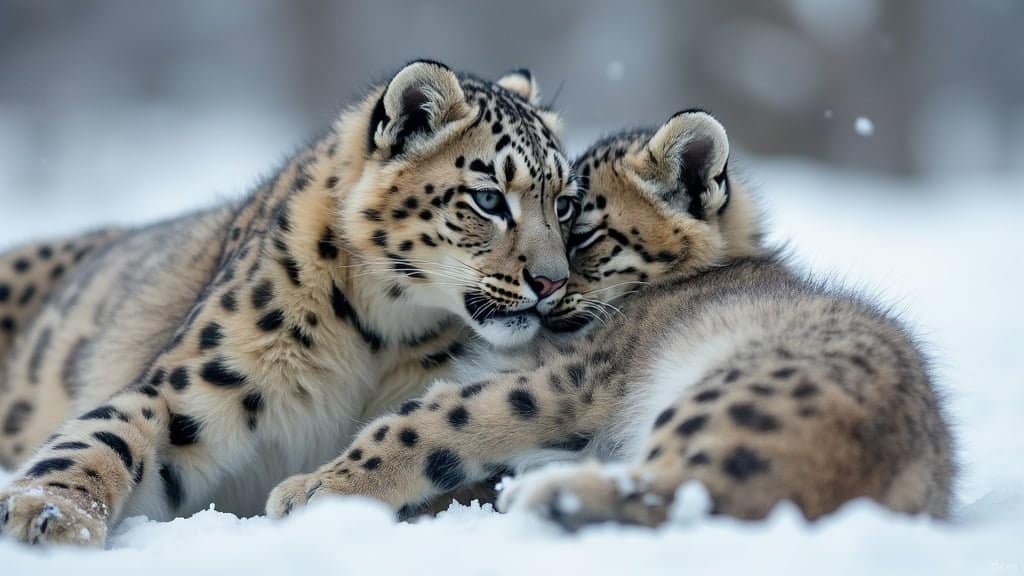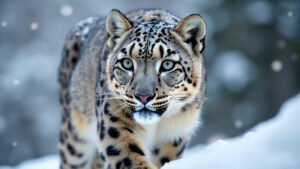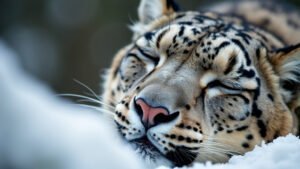Introduction
The Snow Leopard Conservancy plays a pivotal role in protecting one of the world’s most elusive and endangered big cats. This article delves into the diverse strategies employed by the Conservancy to safeguard snow leopards, focusing on habitat protection, anti-poaching measures, and genetic research
We will explore how the organization collaborates with local communities through innovative conservation programs and addresses human-wildlife conflicts. Additionally, we will examine their comprehensive research and monitoring efforts, as well as their educational and outreach initiatives
Finally, we’ll look at the partnerships and funding sources that support their mission. Through these concerted efforts, the Snow Leopard Conservancy strives to ensure a sustainable future for snow leopards and their habitats
Main Conservation Strategies of the Snow Leopard Conservancy
The Snow Leopard Conservancy employs a variety of innovative and comprehensive strategies to protect and preserve snow leopards and their habitats. Central to their mission are habitat protection and restoration, anti-poaching measures, and genetic research and monitoring
Habitat Protection and Restoration
Habitat protection and restoration are crucial to ensuring the survival of snow leopards. The Snow Leopard Conservancy works diligently to identify critical habitats and implement measures to safeguard these areas
They collaborate with local and national governments to designate protected areas and develop management plans that balance conservation needs with the interests of local communities. Restoration efforts focus on rehabilitating degraded landscapes, enhancing prey availability, and mitigating human impact
For instance, the Conservancy has been involved in projects to restore high-altitude grasslands, which are vital for the snow leopard’s prey species such as blue sheep and ibex. These efforts not only improve the habitat for snow leopards but also benefit other wildlife and local ecosystems
Anti-Poaching Measures
Anti-poaching measures are another critical component of the Snow Leopard Conservancy’s conservation strategy
Poaching poses a significant threat to snow leopards, driven by the demand for their pelts and bones in illegal wildlife trade. The Conservancy partners with law enforcement agencies, local communities, and other NGOs to combat poaching through various initiatives
One effective approach is the training and deployment of community-based anti-poaching units. These units, composed of local volunteers, patrol snow leopard habitats, report illegal activities, and assist in apprehending poachers
Additionally, the Conservancy supports the installation of camera traps and other surveillance technologies to monitor key areas and deter poaching activities
Genetic Research and Monitoring
Genetic research and monitoring are essential for understanding snow leopard populations and ensuring their long-term survival
The Snow Leopard Conservancy conducts extensive field studies to gather data on snow leopard genetics, population dynamics, and health status. These studies involve collecting samples such as scat, fur, and tissue from captured individuals, which are then analyzed in laboratories
Genetic research provides insights into the genetic diversity and connectivity of snow leopard populations, helping to identify isolated or vulnerable groups. This information is critical for developing effective conservation strategies and managing populations sustainably
For example, a study published in the journal Ecology and Evolution in 2020 highlighted the importance of maintaining genetic diversity in snow leopards to enhance their adaptability to changing environments (Janečka et al., 2020)
Monitoring efforts also include the use of camera traps and satellite collars to track snow leopard movements and behavior. These technologies allow researchers to gather valuable data on snow leopard home ranges, prey preferences, and interactions with humans
The Snow Leopard Conservancy collaborates with various research institutions and conservation organizations to share data and enhance the overall understanding of snow leopard ecology
Engaging with Local Communities
The Snow Leopard Conservancy places a strong emphasis on engaging with local communities, recognizing that sustainable conservation efforts require the support and involvement of the people who share the snow leopard’s habitat
Through community-based conservation programs, livestock insurance schemes, and local employment opportunities, the Conservancy works to foster positive relationships and mutual benefits
Community-Based Conservation Programs
Community-based conservation programs are at the heart of the Snow Leopard Conservancy’s efforts
These programs involve local communities in conservation activities, promoting a sense of ownership and responsibility for protecting snow leopards and their habitats. By involving communities directly, the Conservancy ensures that conservation measures are culturally appropriate and economically beneficial
One notable example is the formation of Snow Leopard Enterprises (SLE), a program that provides alternative income sources to herder families in exchange for their commitment to protect snow leopards
Families participating in SLE produce and sell handicrafts, with the added benefit of receiving bonus payments if no snow leopards are harmed. This initiative not only reduces retaliatory killings of snow leopards but also empowers local women by providing them with a source of income
Livestock Insurance Schemes
Livestock predation by snow leopards can have severe economic impacts on local herders, often leading to retaliatory killings
To address this issue, the Snow Leopard Conservancy has implemented livestock insurance schemes that compensate herders for losses due to snow leopard attacks. These schemes help to mitigate human-wildlife conflict and reduce the financial burden on herders
Under these insurance programs, herders pay a small premium to participate, and in the event of a predation incident, they receive compensation for the lost livestock. The schemes are managed by local committees, ensuring transparency and community involvement in decision-making
A study published in Conservation Biology in 2019 found that livestock insurance schemes significantly reduce retaliatory killings of snow leopards and increase tolerance among herders (Suryawanshi et al., 2019)
Local Employment Opportunities
Creating local employment opportunities is another strategy used by the Snow Leopard Conservancy to engage communities
By providing jobs related to conservation, the Conservancy helps to alleviate poverty and reduce reliance on activities that may harm snow leopard populations, such as poaching or overgrazing
The Conservancy employs local people as wildlife monitors, guides, and educators. These roles not only provide income but also enhance the skills and knowledge of community members, fostering a deeper understanding and appreciation of snow leopards
Additionally, the Conservancy supports eco-tourism initiatives, which generate revenue for local communities while promoting conservation awareness among tourists
Research and Monitoring Efforts
The Snow Leopard Conservancy’s research and monitoring efforts are crucial for understanding and conserving snow leopard populations. Through camera trap studies, population surveys, and tracking and data collection, the Conservancy gathers essential information to guide its conservation strategies and assess the effectiveness of its programs
Camera Trap Studies
Camera traps are a vital tool in the Snow Leopard Conservancy’s research arsenal. These motion-activated cameras are strategically placed in snow leopard habitats to capture images and videos of these elusive cats. Camera trap studies provide valuable data on snow leopard presence, behavior, and population density
By analyzing the footage collected from camera traps, researchers can identify individual snow leopards based on their unique spot patterns. This non-invasive method allows for long-term monitoring without disturbing the animals
A study published in Biodiversity and Conservation in 2021 demonstrated the effectiveness of camera traps in estimating snow leopard populations across different regions (McCarthy et al., 2021)
Population Surveys
Population surveys are conducted to estimate the number of snow leopards in various habitats and assess their distribution. These surveys combine data from camera traps, field observations, and genetic analyses to provide a comprehensive picture of snow leopard populations
The Snow Leopard Conservancy collaborates with local researchers and communities to carry out these surveys
In addition to counting snow leopards, population surveys also gather information on prey species, habitat conditions, and potential threats. This holistic approach helps to identify priority areas for conservation and informs management plans
Tracking and Data Collection
Tracking and data collection efforts are essential for understanding snow leopard movements, behavior, and ecology
The Snow Leopard Conservancy uses satellite collars and other tracking technologies to monitor snow leopards in the wild. These devices transmit location data, allowing researchers to study snow leopard home ranges, migration patterns, and interactions with other wildlife
For example, a study conducted by the Conservancy in collaboration with the University of California, Berkeley, tracked the movements of snow leopards in the Himalayas using GPS collars. The data revealed that snow leopards have larger home ranges than previously thought, highlighting the need for extensive conservation areas (Johansson et al., 2020)
Data collection also involves gathering samples such as scat, fur, and tissue for genetic analyses. These samples provide insights into the genetic health and diversity of snow leopard populations. Genetic studies help to identify isolated populations, understand population connectivity, and detect potential inbreeding issues
Addressing Human-Wildlife Conflict
Human-wildlife conflict is a significant challenge in snow leopard conservation, as these predators often come into conflict with local communities by preying on livestock. The Snow Leopard Conservancy employs various techniques to mitigate these conflicts, implement compensation programs, and run awareness campaigns to foster coexistence between humans and snow leopards
Conflict Mitigation Techniques
The Snow Leopard Conservancy has developed several conflict mitigation techniques to reduce the likelihood of snow leopards preying on livestock
One effective method is the construction of predator-proof corrals. These reinforced enclosures protect livestock from nocturnal attacks by snow leopards and other predators
The Conservancy also promotes the use of guard dogs, which can deter snow leopards from approaching livestock. Additionally, they work with herders to adopt improved herding practices, such as grouping livestock and maintaining vigilance during grazing. These measures significantly reduce livestock losses and lessen the herders’ inclination to retaliate against snow leopards
Compensation Programs
To address the financial losses suffered by herders due to livestock predation, the Snow Leopard Conservancy has implemented compensation programs. These programs provide financial compensation to herders who lose livestock to snow leopard attacks, helping to alleviate the economic burden and reduce retaliatory killings
The compensation process involves verifying predation incidents through local committees, which ensures transparency and fairness. By compensating herders for their losses, the Conservancy fosters goodwill and cooperation among local communities, encouraging them to support snow leopard conservation efforts
Awareness Campaigns
Raising awareness about snow leopards and the importance of their conservation is another crucial aspect of the Snow Leopard Conservancy’s efforts
Awareness campaigns aim to educate local communities about the ecological role of snow leopards, the benefits of biodiversity, and the need for coexistence
The Conservancy conducts workshops, community meetings, and educational programs to spread awareness. These initiatives often include multimedia presentations, printed materials, and interactive activities to engage participants and reinforce key messages. By increasing knowledge and understanding, the Conservancy aims to change attitudes and behaviors towards snow leopards and promote conservation-friendly practices
Educational and Outreach Programs
Education and outreach are vital components of the Snow Leopard Conservancy’s mission. By fostering a deeper understanding and appreciation of snow leopards and their ecosystems, the Conservancy aims to inspire conservation action and build a foundation for long-term success
Their educational programs, workshops, training sessions, and public awareness initiatives target diverse audiences, including students, community members, and the general public
School and Community Education
The Snow Leopard Conservancy collaborates with schools and community groups to deliver educational programs that emphasize the importance of snow leopard conservation. These programs are designed to engage students and community members through interactive and hands-on activities that promote learning and curiosity
In schools, the Conservancy introduces curricula that cover topics such as snow leopard ecology, conservation challenges, and the significance of biodiversity
Educational materials, including books, posters, and digital resources, are provided to support these lessons. Community education efforts include organizing nature walks, field trips, and conservation-themed events to involve local residents in learning about snow leopards and their habitats
Workshops and Training
Workshops and training sessions are another key element of the Conservancy’s educational outreach. These events provide participants with practical skills and knowledge related to conservation practices and techniques
The Conservancy conducts workshops on topics such as wildlife monitoring, sustainable livestock management, and conflict mitigation strategies
Training programs are tailored to different audiences, including local community members, park rangers, and conservation professionals. By equipping these groups with the necessary skills, the Conservancy enhances the capacity for effective conservation action at the local level
For example, a workshop on camera trapping techniques might cover the proper setup and maintenance of camera traps, data collection protocols, and the analysis of captured images
Public Awareness Initiatives
Public awareness initiatives aim to reach a broader audience and generate widespread support for snow leopard conservation. These initiatives include media campaigns, social media outreach, and public events that highlight the importance of protecting snow leopards and their habitats
The Snow Leopard Conservancy utilizes various media platforms to share stories, research findings, and conservation success stories. Social media campaigns, such as those on Facebook, Twitter, and Instagram, engage followers with captivating visuals and informative content
Public events, including lectures, film screenings, and exhibitions, provide opportunities for people to learn about snow leopards and the Conservancy’s work in a more immersive setting
Partnerships and Funding
Securing partnerships and funding is essential for the Snow Leopard Conservancy to sustain and expand its conservation efforts. By collaborating with governments, NGOs, and the private sector, and through grant programs and donations, the Conservancy builds a robust support network to achieve its mission
Collaborations with Governments and NGOs
The Snow Leopard Conservancy works closely with governments and non-governmental organizations (NGOs) to coordinate and enhance conservation efforts. These collaborations involve joint projects, sharing of resources and expertise, and the development of policies and strategies to protect snow leopards
Government partnerships are particularly important for establishing and managing protected areas, enforcing anti-poaching laws, and conducting large-scale research and monitoring programs
For example, the Conservancy collaborates with the governments of countries within the snow leopard range, such as India, Nepal, and Mongolia, to implement national and regional conservation plans
NGO partnerships provide additional support and resources, enabling the Conservancy to reach more communities and address a broader range of conservation challenges. Collaborations with organizations like the World Wildlife Fund (WWF) and Panthera enhance the effectiveness of conservation programs and facilitate the exchange of knowledge and best practices
Grant Programs and Donations
Grant programs and donations are crucial sources of funding for the Snow Leopard Conservancy
The organization applies for grants from foundations, government agencies, and international bodies to support specific projects and initiatives. These grants provide the financial resources needed to conduct research, implement conservation strategies, and engage with local communities
Individual donations also play a significant role in funding the Conservancy’s activities. The organization reaches out to donors through various channels, including direct mail campaigns, online fundraising platforms, and special events. Donors are often motivated by a personal connection to snow leopards or a desire to contribute to wildlife conservation
Corporate Sponsorships
Corporate sponsorships offer another avenue for securing funding and support. The Snow Leopard Conservancy partners with businesses and corporations that share its commitment to conservation and sustainability. These partnerships can take various forms, including financial contributions, in-kind donations, and employee engagement programs
Corporate sponsors benefit from association with a reputable conservation organization, enhancing their corporate social responsibility (CSR) profiles and engaging their customers in meaningful environmental causes. For example, outdoor gear companies might sponsor snow leopard conservation projects, aligning their brand with wildlife protection and sustainable practices
Conclusion
The Snow Leopard Conservancy is dedicated to preserving snow leopards and their habitats through comprehensive and multifaceted conservation strategies. By focusing on habitat protection, anti-poaching measures, and genetic research, the Conservancy ensures the long-term survival of snow leopards
Engaging local communities through conservation programs, livestock insurance schemes, and employment opportunities fosters mutual benefits and promotes coexistence. Rigorous research and monitoring efforts provide essential data to guide conservation strategies, while addressing human-wildlife conflict through mitigation techniques, compensation programs, and awareness campaigns helps reduce tensions
Educational and outreach initiatives inspire conservation action by informing and involving diverse audiences. Partnerships with governments, NGOs, and corporations, alongside funding from grants and donations, provide the necessary support for the Conservancy’s mission. Through these combined efforts, the Snow Leopard Conservancy continues to make significant strides in protecting one of the world’s most elusive and endangered big cats











